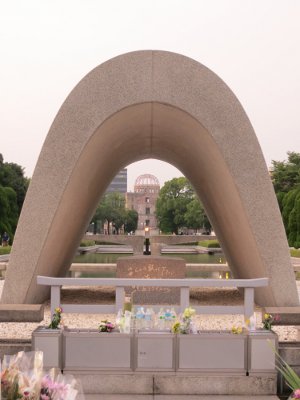No More Hiroshimas!
During our days in Hiroshima we visited the Atomic Bomb Dome, Peace Memorial Park, Hiroshima National Peace Memorial Hall, and Peace Memorial Museum. All these places confined living testimonies of the atomic attack, including the ruins of a building that was near the hypocenter, many memorials, testimonials of the survivors, graphic evidence of the terrible effects of radiation on children and adults, and multiple efforts of new generations to commemorate this tragedy advocating for world peace. After witnessing the atrocities of humankind and crying out the horrors of war, we felt inspired us to write about what we learned in order to not repeat the past.


On August 6, 1945, the first atomic attack against humankind took place in Hiroshima, Japan. This attack was performed by the United States Army during War World II. At the instant of detonation, the bomb generated tremendous heat and blast. Heat from the super-hot fireball raised temperatures on the ground near the hypocenter to 3,000 to 4,000 degrees centigrade, igniting fires throughout the city. Within two kilometers of the hypocenter, most buildings were totally collapsed and burned. The bomb took the lives of 140,000 people and many others survived to suffer from diseases that didn’t develop until after the years.

The damage done by the atomic bomb to human bodies does not heal with the passing of time. This is the peculiar horror of radiation. Japan’s atomic bomb disease research, greatly restricted during the occupation, finally began to progress after Japan’s independence. Questions remain even today about the long-range effects of radiation from the atomic bomb on the human body. Radiation penetrated human bodies and damaged cells, causing serious health effects which not necessarily manifest immediately after exposure. Symptoms can appear many years later. In Hiroshima, many children exposed to radiation in their mother’s womb were born with what became known “a-bomb microcephaly” and they suffered from mental retardation and physical disabilities. Leukemia also became a recurrent illness, taking the lives of many children exposed to radiation in Hiroshima. Because radiation affects the genetic information of growing cells, it is extremely detrimental for children which are at the highest stage of development.
The US Army repeated the atomic bomb in Nagasaki three days after the tragedy in Hiroshima. Both cities have become examples of human resiliency and a claim for world peace. Education and awareness about the horrors of war and nuclear weapons continue to be the long lasting commitment of many survivors and their descendants. Thousands of people from different countries gather around the sad memories and testimonies of these towns to learn about the greatest human disaster of the 20th century, hoping evil never repeats!
Unfortunately countries like United States, Russia, United Kingdom, France, China, Israel, India, Pakistan, Iran, and North Korea haven’t learned the lesson. Even after these terrible tragedies, they conduct nuclear tests and have publicly declared or being suspected to have nuclear weapons. Although in July 1991, the United States and the Soviet Union signed an agreement to reduce their nuclear weapons, the risk of creating and possessing this type of massive destructive bombs continues to be imminent for humanity and all living creatures on earth. As long as nuclear weapons exist, we will face the terrible possibility of nuclear war. Furthermore, the ongoing functioning of nuclear power plants in countries like Japan continues to be a serious issue to our safety.
68 years after the Atomic Bomb was dropped in Hiroshima, we are remembering and reflecting on the horrors of war. We wonder if one day humankind could live in peace. Evil should not be repeated! Science, research, and knowledge should be used with the purpose of preserving the environment and wellbeing of all living species on earth. The existence of nuclear weapons, nuclear energy plants, and radiation continue exposing us to imminent danger. Raising awareness is a way of not giving up on the dream of a world where all our uniqueness, boundaries, and differences could be respected. No more Hiroshimas and Nagasakis!
